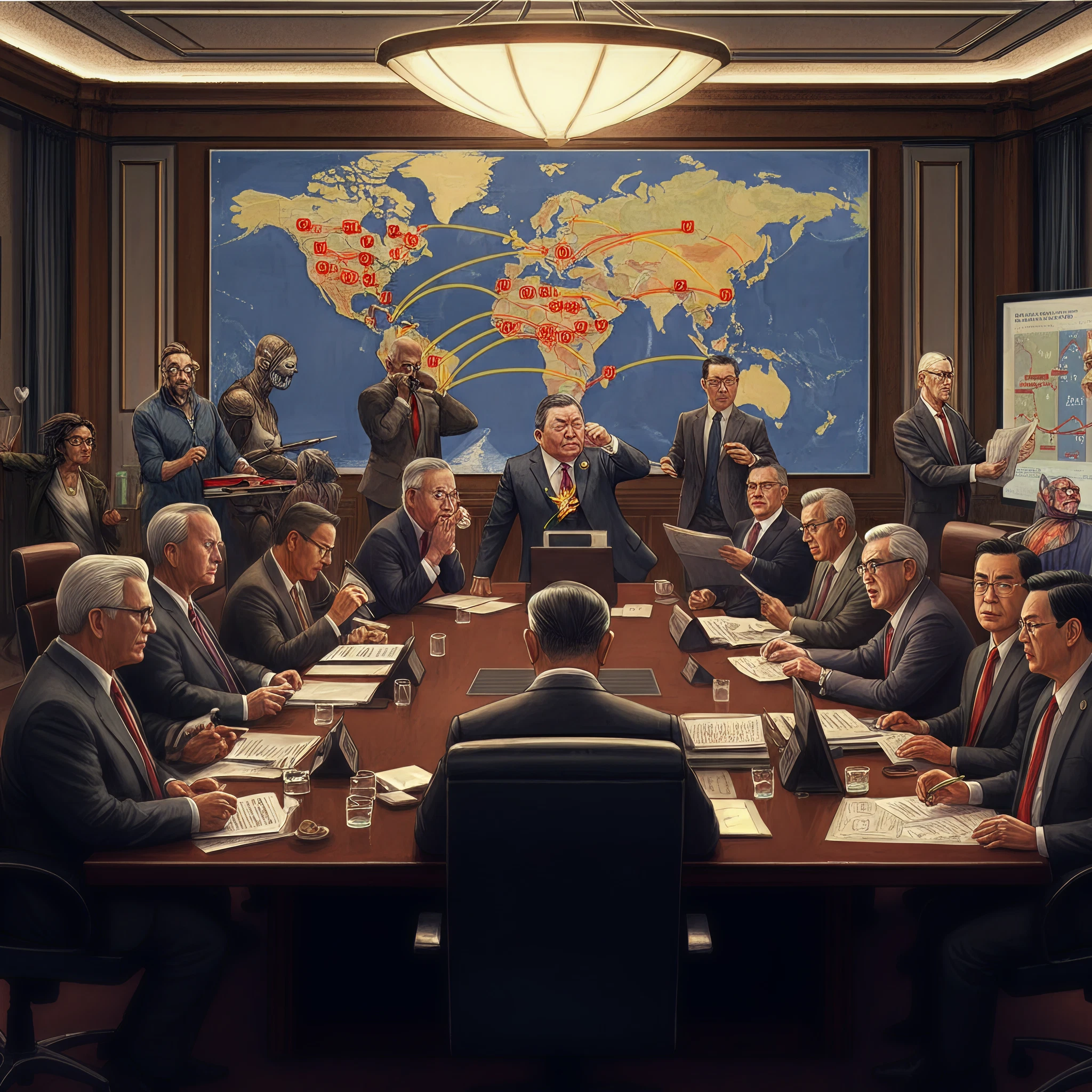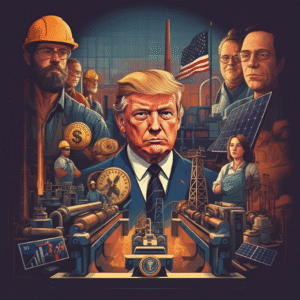The U.S.-China trade war is more than just a series of tariffs and trade restrictions; it’s a pivotal geopolitical event reshaping the global economy.
Since the clash began in 2018, its consequences have rippled through industries, supply chains, and nations worldwide. For business professionals, corporate leaders, economists, and policymakers, understanding the trade war’s intricacies is vital for navigating an increasingly complex global economic landscape.
This comprehensive blog explores the origins, key policies, economic consequences, and global impacts of the U.S.-China trade war. Additionally, it outlines industry-specific effects, the geopolitical ramifications, and potential pathways to resolution, giving readers actionable insights to address emerging challenges.
Key takeaway: The U.S.-China trade war is not just a bilateral issue but a defining event influencing global trade, markets, and industries. Here’s everything you need to know.
Overview of the U.S.-China Trade War
A Brief History of Tensions
Tensions between the U.S. and China have simmered for decades, but the trade war escalated dramatically during the administration of President Donald Trump. The primary grievances included trade imbalances, violations of intellectual property rights, technology theft, and geopolitical rivalries. While economic relationships between the two nations had grown stronger post-China’s accession to the World Trade Organization (WTO) in 2001, these underlying frictions made conflict inevitable.
During his presidency, Trump implemented tariffs on billions of dollars worth of Chinese goods in an effort to reduce the trade deficit and protect American industries. China retaliated with their own set of tariffs, leading to a back-and-forth escalation that impacted global markets and caused disruptions in supply chains.
The U.S.-China trade war had wide-ranging effects on various industries, including agriculture, manufacturing, and technology. American farmers were hit hard by China’s retaliatory tariffs on agricultural products such as soybeans and pork. As a result, the U.S. government provided billions in aid to farmers affected by the trade war.
Why Understanding This Matters
The U.S. and China represent the world’s largest economies, collectively accounting for over 40% of global GDP. When these giants clash, the economic consequences affect not only their citizens but also emerging markets, multinational corporations, and vulnerable industries. By studying the trade war, businesses and policymakers can better anticipate risks, adapt strategies, and seize opportunities.
Key Sectors Impacted
The U.S.-China trade war has had a profound impact on several key sectors. Agriculture has been one of the hardest-hit industries, with American soybean farmers losing access to their largest export market after China imposed retaliatory tariffs. Similarly, the technology sector has faced significant fallout, as restrictions on Chinese telecommunication companies and tariffs on electronic components disrupted global supply chains. The manufacturing industry experienced rising production costs due to increased tariffs on imported raw materials, further straining profit margins. Understanding these sector-specific effects provides insight into how trade policy shifts can ripple through the global economy.

Origins of the U.S.-China Trade War
Key Events Leading to the Trade Conflict
- Trade Deficit Concerns
The U.S.’s trade deficit with China reached $375 billion in 2017, a catalyst for mounting frustrations in Washington. China’s trade surplus with the U.S. is largely driven by imports of electronics, machinery, and furniture. This has resulted in job losses in these industries as American manufacturers struggle to compete. American policymakers have pressured China to reduce its trade deficit through increased purchases of U.S. goods.
- Intellectual Property Rights (IPR) Infringement
- Intellectual Property (IP) Theft Allegations
The theft of intellectual property rights by Chinese firms has been a long-standing concern for the U.S., with an estimated cost of $225 billion to $600 billion annually for American companies. In addition, forced technology transfer – where foreign companies must share their technology with Chinese partners in order to do business in the country – has further
The U.S. accused China of engaging in technology theft, forced technology transfers, and inadequate IP protection for over a decade. Estimates suggest that U.S. businesses lose roughly $225–600 billion annually due to IP infringement by China.
- China’s Economic Rise
China’s meteoric rise through state-supported initiatives like “Made in China 2025” posed a direct challenge to U.S. technological and economic dominance. Despite initial efforts to engage with China and benefit from its economic growth, the U.S. increasingly saw China as a threat to its global hegemony.
As China’s economy continued to grow at an unprecedented rate, it began investing heavily in emerging technologies such as artificial intelligence, biotechnology, and renewable energy. This further fueled concerns in the U.S. about China’s intentions and actions regarding technology transfer and intellectual property protection.
- The Trade War
- Section 301 Investigation
The escalating tensions between the U.S. and China eventually led to a full-blown trade war between the two countries. In July 2018, the U.S. imposed tariffs on $50 billion worth of Chinese imports,
The U.S. Trade Representative (USTR) launched an investigation into China’s trade practices in 2017, culminating in sweeping tariffs and restrictions.
Policy Shifts Over Presidential Administrations
- Obama Era
Policies prioritized collaboration with China while addressing concerns through diplomacy and multilateral institutions.
- Trump Era
- Trump Administration
Policies emphasized confrontation and protectionism, with an increased focus on bilateral trade deals and utilizing tariffs as a tool in negotiations.
- Biden Era
Though still early in his presidency, Biden has signaled a shift towards cooperation with allies to address China’s economic practices, while also maintaining tough stances on issues such as human rights abuses.
Impact on Global Economy and Trade
The U.S.-China trade war has had significant impacts on the global economy and international trade. Some of the major effects include:
- Disruptions in Supply Chains – The imposition of tariffs has disrupted global supply chains, particularly for industries heavily reliant on Chinese imports such as electronics
Marked by an aggressive stance, President Trump escalated sanctions, tariffs, and public criticisms of China’s practices.
- Biden Administration
While softer in rhetoric, the Biden administration reinforced tariffs, emphasizing competition rather than direct confrontation.

Key Tariffs and Policies Implemented During the Trade War
U.S.-Imposed Tariffs
The U.S. levied tariffs on over $550 billion worth of Chinese goods, ranging from technology to consumer products. Key categories targeted included electronics, machinery, and plastics. Tariff rates ranged from 10 to 25%. In addition, the U.S. blacklisted over 300 Chinese companies, including major tech firms like Huawei and ZTE. This effectively prohibited American companies from doing business with them without a special license.
Chinese Retaliation
In response to the U.S. tariffs, China imposed its own set of retaliatory tariffs on American goods worth $185 billion. These included agricultural products such as soybeans, pork, and cotton, as well as other commodities like chemicals and airplanes. Additionally, China implemented non-tariff barriers such as increased inspections and regulations on imported goods from the U.S.
Phase One Trade Agreement
In January 2020, both countries signed a preliminary trade deal known as the “Phase One” trade agreement. Under this agreement, China committed to purchasing an additional $200 billion worth of American goods over the next two years, including agricultural products, manufactured goods, energy products, and services. In return, the U.S. agreed to reduce some of its existing tariffs on Chinese goods and refrain from implementing new ones.
Impact on Global Economy
The ongoing trade war between the U.S. and China has had a significant impact on the global economy. The uncertainty caused by these tensions has led to a slowdown in economic growth and investment worldwide. Companies have been forced to adjust their supply chains and face higher costs due to increased tariffs.
China’s Retaliatory Measures
China imposed its own tariffs on $185 billion in American goods, hitting agriculture (soybeans, pork), energy (natural gas), and automobiles. The purpose of these tariffs was to target key industries in the U.S. and put pressure on President Trump’s voter base.
Moreover, China has also taken non-tariff measures such as delaying customs clearance for American products entering their market, leading to significant delays and losses for American businesses. Chinese consumers have also been encouraged to boycott American goods, further impacting sales and revenue for U.S. companies.
Impact on Global Trade
The trade war between the world’s two largest economies has caused disruptions in global trade patterns, with other countries getting caught in the crossfire. Countries that heavily rely on exporting raw materials or manufactured goods to either the U.S. or China have experienced a decline in demand, leading to lower economic growth and job losses.
As a result of the trade war, there has been an increase in protectionist policies and retaliatory tariffs imposed by other countries. This could potentially lead to a slowdown in global trade and economic growth, ultimately affecting the stability of the global economy.
Shift in Supply Chains
The trade war has also caused companies to rethink their supply chains. Many American businesses that rely on Chinese imports have started looking for alternative suppliers in neighboring countries such as Vietnam or Thailand. This shift requires significant investments and may take time to fully implement, resulting in increased costs for businesses.
Non-Tariff Barriers
Both nations implemented regulatory barriers, such as restrictions on technology transfers, tightened export controls on semiconductor equipment, and enhanced scrutiny of foreign investments. These non-tariff barriers are intended to protect the domestic economy and national security, but they also limit trade and investment between the two countries. Moreover, the uncertainty surrounding these regulations can create additional challenges for businesses trying to navigate the complex trade landscape.
Impact on Small Businesses
Small businesses have been hit especially hard by the ongoing trade tensions between the US and China. These businesses often lack the resources and flexibility to adapt quickly to changing market conditions, making it difficult for them to absorb rising costs or find alternative suppliers. Many small businesses rely heavily on Chinese imports, and any disruption in supply chains can have a significant impact on their operations.

Economic Consequences for the United States
Rising Costs for Businesses and Consumers
Tariffs led to increased input costs for manufacturers and inflated prices for consumers. For instance, steel tariffs raised the cost of goods for U.S. manufacturers reliant on Chinese imports. These higher costs can ultimately be passed on to consumers, resulting in increased prices for everyday goods. In addition, tariffs on Chinese imports have led to retaliatory measures from China, further increasing the cost of goods for U.S. businesses and consumers.
Impacts on Job Market
Tariffs have also had a significant impact on the job market in the United States. With rising costs and uncertainty surrounding trade policies, businesses may be hesitant to expand or hire new employees. The National Association of Manufacturers estimated that over 400,000 jobs could be lost due to the tariffs imposed on Chinese imports.
Job Market Disruptions
Industries heavily reliant on imported components, such as electronics and automotive manufacturing, reported significant layoffs and downsizing due to higher costs. This not only affects employees directly impacted by these job losses, but also has a ripple effect on the overall job market and economy.
Impact on Consumers
The effects of tariffs are not limited to businesses and industries. Consumers may also feel the impact through higher prices for goods affected by the tariffs. For example, the cost of household appliances, electronics, and vehicles could all see an increase due to tariffs on imported components. This could lead to decreased consumer spending, which can have detrimental effects on the economy.
Retaliation from Other Countries
In addition to impacting American businesses and consumers, tariffs can also lead to retaliatory measures from other countries.
imposes its own set of tariffs in response. This tit-for-tat strategy can escalate trade tensions, disrupt international relationships, and further strain the global economy, creating prolonged challenges for all parties involved.
Agriculture and Farming Sector Impact
American farmers, particularly those exporting soybeans and pork, suffered due to retaliatory Chinese tariffs. Although government subsidies helped mitigate losses, long-term damage to trade relationships persisted.
Inflation and GDP Growth Impact
Tariffs added upward pressure on inflation, while economists estimate that the trade conflict reduced U.S. GDP by 0.3% annually. This is significant considering that the U.S. economy has been experiencing steady growth in recent years.
Consumer Impact
U.S. consumers ultimately bore the brunt of the trade war through higher prices on goods affected by tariffs. A study by the Federal Reserve Bank of New York estimated that tariffs cost the average American household $831 per year, mainly due to increased prices on Chinese imports.
Business Impact
The uncertainty created by the trade war led to a slowdown in business investment and hiring, as companies awaited a resolution before making major decisions. The manufacturing sector was particularly hit hard, with declines in both output and new orders.
Stock Market Impact
Stock market volatility increased significantly during periods of heightened trade tensions, with major indexes experiencing sharp declines. This volatility not only affects individual investors, but also the overall economy as businesses rely on stable markets to make long-term investment decisions.
International Relations
The trade war has strained relations between the United States and China, two of the world’s largest economies. It has also affected relationships with other countries, as they navigate how to respond to the escalating tensions and potential consequences for their own economies.
Global Economy
The ripple effects of the trade war are felt beyond just the US and China. As both countries impose tariffs on each other’s goods, it disrupts global supply chains and has a domino effect on other countries’ economies.

Economic Consequences for China
Decline in Exports to the U.S.
Chinese exports to the U.S. fell by more than 20% in 2019, forcing Chinese firms to pivot to alternative markets. This decline in exports has led to a decrease in manufacturing activity and job losses in China.
Impact on Consumer Spending
The trade war has also affected consumer spending in China, as the tariffs have made imported goods more expensive. This, coupled with the slowing economy, has led to a decrease in consumer confidence and spending.
Devaluation of Chinese Currency
In response to the trade war, China has devalued its currency, making its exports cheaper and potentially increasing demand for them. However, this move has also sparked fears of a currency war and further destabilization of global markets. The devaluation also makes it more expensive for Chinese citizens to purchase imported goods, further impacting consumer spending.
Impact on Global Economy
The trade war between the US and China has had a significant impact on the global economy. With two of the largest economies in the world engaged in a trade dispute, there is bound to be ripple effects felt across other countries and industries. The uncertainty and volatility caused by the trade war have led to decreased investments and hindered economic growth worldwide. It has also sparked fears of a recession as businesses struggle with increased costs and disrupted supply chains.
Potential Resolutions
Despite ongoing negotiations, no concrete resolutions have been reached between the US and China to end the trade war. However, there are potential routes that could lead to a resolution in the future.
- Bilateral Trade Agreements: One possible solution is for the US and China to negotiate bilateral trade agreements outside of the larger trade dispute. This would involve both countries discussing and agreeing upon specific issues such as tariffs and intellectual property rights.
- Multilateral Approaches: Another approach could be for other countries or organizations, such as the World Trade Organization (WTO), to mediate the dispute and help facilitate a resolution between the US and China.
- Political Pressure: As public opinion turns against the trade war, there may be increased pressure on leaders from both sides to come to a resolution in order to appease their constituents.
- Long-Term Effects: The trade war may have long-term effects on the global economy, as well as the relationship between the US and China. This could result in changes in supply chains, investments, and trade patterns that could potentially last for years to come.
These are just a few possible scenarios and approaches that could play out in the ongoing US-China trade war. Ultimately, it is impossible to predict how this conflict will be resolved or what the lasting implications may be. However, one thing is certain – finding a resolution will require open communication, compromise, and cooperation from both sides.

Economic Consequences for the U.S.
Rising Costs for American Businesses
As tariffs increase the cost of imported goods, American businesses that rely on these products will have to absorb the higher costs or pass them onto consumers in the form of higher prices. This can lead to decreased sales and profits for these businesses, potentially resulting in layoffs and closures.
Impact on Consumers
The increased tariffs also directly impact American consumers, as they may see price increases for everyday items such as clothing, electronics, and groceries. This can result in a decrease in purchasing power and overall economic strain for households.
Effects on U.S. GDP
The trade war could also have significant consequences for the overall U.S. economy. A study by Moody’s Analytics estimated that if all proposed tariffs are put into effect, it could reduce the U.S. GDP by 0.25% and cost 190,000 jobs by 2020.
Effects on International Trade
The trade war has also led to a decline in international trade, as other countries respond with their own tariffs on U.S. goods. This can have long-term effects on global supply chains and disrupt established trade relationships.
Potential for Escalation
As tensions continue to rise between the U.S. and China, there is a risk of further escalation in the form of additional tariffs or even non-tariff barriers such as increased regulations or restrictions on investment. This could lead to even greater economic consequences for both countries and potentially impact the global economy as a whole.
Impact on Consumers
The trade war between the U.S. and China also has direct consequences for consumers. As tariffs are imposed, the cost of imported goods from China will likely increase, leading to higher prices for American consumers. This can have a ripple effect throughout the economy as increased costs may result in companies passing on these expenses to consumers through higher prices for their products and services.
Potential for Innovation
On the other hand, some analysts argue that this trade war could also lead to positive outcomes such as encouraging innovation and diversification within supply chains.
Challenges for SMEs and Manufacturing
Small and medium enterprises (SMEs) in China struggled with declining demand, rising production costs, and labor migration.
Impact on Global Markets
The trade war has significantly influenced global markets, creating volatility and uncertainty for businesses and investors alike. Stock markets around the world have experienced fluctuations in reaction to tariff announcements and ongoing negotiations. For exporters in both China and the United States, the increased tariffs have resulted in higher costs, making their goods less competitive on the international stage. This ripple effect has extended to other economies, particularly those heavily reliant on global trade, such as Germany, Japan, and South Korea.
Strain on Bilateral Relations
Beyond the economic impact, the trade war has placed additional strain on the political and diplomatic relationship between the United States and China. Long-standing issues such as intellectual property rights, market access, and currency manipulation have come to the forefront, further complicating negotiations. The heightened tension has fostered an environment of distrust, influencing other areas of bilateral cooperation, including climate change and regional security.
Consumer Implications
For consumers in both countries, the trade war has brought mixed consequences. Many products, especially electronics and household goods, have faced price increases due to the tariffs. However, initiatives to reduce reliance on imported goods have also led to the promotion of domestic alternatives. While this may benefit local industries in the long term, it has created short-term challenges for lower-income households struggling to absorb the rise in prices.
Domestic Economic Strategy
China increasingly focused on boosting domestic consumption and reducing reliance on global trade. Policies, such as the “dual circulation” strategy, emphasized self-reliance.
Global Manufacturing Dominance at Risk
The trade war intensified the shift of manufacturing hubs to countries like Vietnam, Malaysia, and India, threatening China’s long-held dominance.

Global Ripple Effects of the Trade War
Supply Chain Disruptions
The trade war disrupted global logistics networks, causing wrenching delays, higher costs, and product shortages.
Impact on Technology and Innovation
The trade war also heavily affected the technology sector, as tensions between the U.S. and China escalated in areas such as 5G technology, semiconductors, and artificial intelligence. Export restrictions on critical U.S. tech components, such as microchips, hampered Chinese companies’ ability to compete on a global scale. Conversely, China accelerated its push for technological self-sufficiency through increased investment in domestic research and development and the creation of its own semiconductor supply chain. This bifurcation of the tech industry has led to the emergence of parallel ecosystems, with long-term implications for global innovation and collaboration.
Financial Market Instability
Global financial markets experienced significant volatility as a result of the trade war. Tariff increases and retaliatory measures created uncertainty for businesses, leading to fluctuations in stock markets worldwide. Investors were prompted to reevaluate their portfolios amid concerns over reduced corporate earnings and slower economic growth. Some emerging markets, dependent on trade with both the U.S. and China, faced compounded challenges, including currency depreciation and declining foreign investment.
Long-Term Implications for Global Trade
The trade war underscored the fragility of the global trade system, sparking a reevaluation of economic dependencies across nations. Countries are diversifying their trade partners and prioritizing regional agreements to mitigate risks associated with reliance on major powers like the U.S. and China. This shift may signal a move towards a more fragmented global trade environment, altering the dynamics of globalization for years to come.
Effects on Emerging Economies
Countries like Brazil, Vietnam, and Mexico benefited as they stepped into the void created by reduced U.S.-China trade.
Multinational Companies
Companies operating in both countries, such as Apple and Tesla, faced unprecedented challenges, including divided supply chains and compliance risks. These companies have had to adapt quickly and diversify their operations in order to navigate the changing trade landscape.
Innovation and Technological Advancements
With the U.S. and China at odds, there may be a slowdown in collaboration on innovation and technological advancements between the two countries. This could lead to delayed progress in areas such as renewable energy, artificial intelligence, and biotechnology.
Impact on Consumer Goods
The trade war has also impacted consumer goods, with both countries imposing tariffs on a wide range of products from electronics to clothing. This has resulted in higher prices for consumers and reduced choices as some products become more expensive or unavailable due to tariffs.
Industry-Specific Impacts
- Technology
Tech firms bore the brunt, with disruptions to semiconductors, 5G networks, and electronics supply. Huawei, for instance, faced a significant blow due to U.S. sanctions.
- Automotive
- Automotive
The automotive sector, especially auto parts manufacturers and vehicle assembly plants, faced significant disruptions due to the tariffs and trade war. Both countries imposed hefty duties on automobile imports from each other.
- Agriculture
Agriculture is another industry that has been adversely affected by the trade war. China’s retaliatory tariffs have hit U.S. farmers hard, resulting in reduced exports of crops such as soybeans, pork, and dairy products.
- Textile and Clothing
The textile and clothing industry has also been impacted by the trade tensions between the U.S. and China. With increased tariffs on Chinese goods, many companies have shifted
Vehicle manufacturers, reliant on a mix of U.S. and Chinese components, struggled with rising costs and logistical issues.
Global soy markets recalibrated as China turned to Brazil, affecting U.S. farmers. The U.S. lost its spot as China’s top agricultural supplier, with Brazil taking over the role.
In addition, pork and dairy exports to China have also been impacted by the trade tensions, leading to losses for American farmers.
- Technology
- Retail and Consumer Goods
Technology is another area that has been affected by the U.S.-China trade tensions. With tariffs imposed on Chinese technology products, companies in both countries have faced
increased costs and disruptions in supply chains. This has also led to concerns about the development of emerging technologies such as artificial intelligence and 5G,
which require collaboration between U.S. and Chinese companies.

Geopolitical Impacts of the Trade War
Strengthening Alliances
Countries moved towards deeper alliances to reduce reliance on U.S.-China trade. For example, the EU intensified trade agreements with Japan and Canada.
China’s Belt and Road Initiative
China ramped up investment in its Belt and Road initiative to expand influence beyond traditional trade partners. This includes investing in infrastructure and development projects across Asia, Africa, and Europe.
Shifts in Global Supply Chains
The trade war prompted companies to reassess their supply chain strategies. Many businesses looked to diversify their sourcing away from China to mitigate the risk of future tariffs or disruptions.
Economic Slowdown in China
The trade war also had a significant impact on China’s economy, causing a slowdown in growth. This could have long-term implications for global economic stability as China is the second-largest economy in the world.
Impact on Consumer Prices
Tariffs can drive up consumer prices as businesses pass on the cost of increased import taxes to consumers. American consumers may see higher prices for goods imported
Regional Trade Pacts
The Comprehensive and Progressive Agreement for Trans-Pacific Partnership (CPTPP) and the Regional Comprehensive Economic Partnership (RCEP) gained momentum, reducing U.S. global trade leverage.
Efforts at Resolution and De-escalation
Although multiple rounds of talks and interim agreements were attempted, long-term resolution remains elusive. Experts suggest greater involvement of neutral institutions, such as the WTO, to mediate disputes.

Long-term Implications for the Global Economy
Emerging trends point to a bifurcated global economic system, where the U.S. and China dominate separate trading blocks. Businesses must adapt by diversifying markets, rethinking supply chains, and staying attuned to geopolitical risks. Nations must learn resilience by minimizing overdependence on any single partner. In the long-term, a trade war could result in a global economic slowdown as businesses and consumers bear the brunt of higher tariffs and reduced access to goods and services.
The ongoing trade tensions between the U.S. and China have caused uncertainty and volatility in financial markets worldwide. This has led to concerns about the potential for a recession, as well as its impact on job growth, consumer spending, and overall economic growth. Additionally, there are fears that escalating tariffs could lead to inflationary pressures which would further harm the global economy.
Furthermore, a prolonged trade war could also have negative effects on developing countries that are heavily reliant on exports to the U.S. or China. These nations may see a decrease in demand for their goods and services, leading to a decline in their economies. This could also have ripple effects on other countries that have close economic ties with these developing nations.
Impact on Global Supply Chains
The trade war is also causing significant disruptions to global supply chains. Many multinational corporations rely on components and raw materials sourced from both the U.S. and China, and increased tariffs have raised costs, forcing businesses to either absorb the losses or pass them on to consumers. Additionally, companies may need to reconfigure their supply chains, seek alternative suppliers, or relocate production to other countries, which can be time-consuming and costly. This reorganization could lead to inefficiencies and further reduce global economic growth in the short term.
Conclusion
In conclusion, the ongoing trade tensions between the U.S. and China have far-reaching implications for businesses, consumers, and the global economy. While some companies may adapt to these challenges through innovation and diversification, the overall economic landscape remains uncertain. Collaborative efforts and diplomatic solutions will be essential to mitigate the negative effects and foster sustainable growth in an increasingly interconnected world.
FAQs
- What triggered the U.S.-China trade war? A combination of trade imbalances, IP theft allegations, and geopolitical tensions.
- How has it affected global trade relationships? It spurred diversification of trade partnerships and manufacturing hubs.
- Are there winners? Emerging economies like Vietnam gained manufacturing opportunities, but most markets felt adverse effects.
- What sectors were hit hardest? Technology, agriculture, and consumer goods bore the brunt.
- What role did tariffs play in the trade war? Tariffs were a key tool used by both nations, with substantial duties imposed on hundreds of billions of dollars’ worth of goods.
- Has the trade war impacted consumers? Yes, consumers experienced higher prices on various goods due to increased production costs and import fees.
- Is there a resolution in sight? While certain trade agreements have been signed, lingering tensions and unresolved issues suggest a complete resolution remains uncertain.










